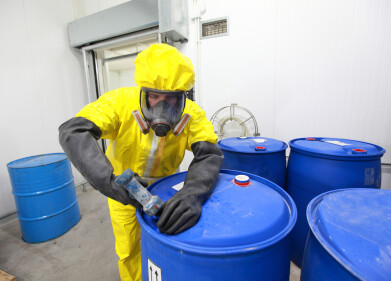Elemental analysis
Interview with Dr. Siqi Sun - How new instruments meet the needs of the oil, gas and petrochemical industry
Jul 30 2021
In this interview, Dr. Siqi Sun, PhD, application scientist at Analytik Jena US, discusses the elemental analysis requirements of the oil industry and three instruments that help meet those requirements.
Q. What are customers’ elemental analysis requirements in the oil industry?
A. Depending on the scope of the individual lab, these can vary greatly—from an R&D lab that requires maximum instrument flexibility to adapt to different applications to a routine QC lab that runs the same applications 24/7. As such, an instrument must be able to analyze different sample types (e.g., gas, high viscosity, high volatile, solids). The multi EA 5100 Elemental Analyzer, in particular, was designed with these requirements in mind. Its modular design allows the instrument to be customized according to an individual lab’s requirements. The instrument also enables easy operation at high sample throughput, low detection limits, and reliable analytical results, so even inexperienced lab techs can understand the instrument and run it at the basic level. Instruments that are built for the long haul—durable, robust, and stable—and require minimum downtime, quick maintenance, and maximum operational safety are essential for time- and cost-savings.
Q. What are the applications of the PlasmaQuant 9100 ICP-OES and the multi EA 5100 elemental analyzer in the oil and gas and petrochemical sectors?
A. Both instruments are used for element detection—the PlasmaQuant for metals and the multi EA 5100 for non-metals. Therefore, they are complementary to each other and provide a comprehensive solution for petrochemical laboratories. Both instruments are ideal for product QC and product specification of fuels, oils, or precursors to the chemical industry such as naphtha. Additionally, process control and feedstock impurity analysis can be addressed in order to improve the performance and efficiency of the refining processes.
The multi EA 5100 is a combustion analyzer that offers access to the detection of critical elements such as sulfur, chlorine, and nitrogen from ultra-trace levels up to percentage content. The PQ 9100 allows users to measure metals in feed stock, intermediate, and final products—for example, full element portfolio in crude oil: As, Hg, V, Ni, Na, Si, P, Fe, etc.
Q. What makes the ICP-OES adaptable to oil and gas applications? How is it universally applicable?
A. The PQ 9100 is universally applicable for several reasons. First, the industry-leading spectral resolution helps eliminate spectral interferences and contributes to the excellent sensitivity and detection limits of the PQ 9100. In combination with a charge-coupled device (CCD) detector, it enables fast analysis of complex samples with highest confidence in the results. Second, the plasma is extraordinarily robust when it comes to measuring heavy matrix samples, such as undiluted solvents and alcohols, while maintaining detection limits.
Third, the V-shuttle torch plug-and-play design simplifies daily maintenance and minimizes consumables cost. The torch is fully demountable and allows individually interchangeable torch components with no need for alignment. The torch design of the PQ 9100 reduces the carbon deposits to a minimum, even without the addition of oxygen to the plasma when running organic solvents.
In addition, the analysis of trace and major elements in the plasma requires different plasma observation modes. Our Dual View PLUS enables the free selection of 2+2 plasma views in every sample range—from ppb to high weight percentage. Lastly, automatic data processing software tools such as automatic baseline correction (ABC) simplify data evaluation and eliminate human error in the data analysis by minimizing user interventions.
Q. What about the EA 5100? Why is it adaptable to oil and gas applications?
A. The multi EA 5100 is extremely versatile and was developed to fulfill all requirements of modern petrochemical laboratories—up, mid, and downstream—in R&D as well as routine QC. In addition to the testing of carbon, nitrogen, sulfur, and chlorine, it enables the analysis of important environmental parameters such as TOC
and AOX/TOX and EOX as secondary applications. It is optimal for oil and gas, petrochemical and chemical, and polymer industries. C/N/S/X testing is carried out in one analysis cycle, and the change between C/N/S and X determination is fully automatic, with no user intervention required. The multi EA 5100 is also compliant with most international and national regulations (ASTM, EPA, DIN, ISO, EN, etc.)
The preset standard methods in the software simplify end user’s operation and reduce measuring time. Additional features include:
- Auto protection and a self-check system to maximize operational safety and comfort for users of any level of experience
- A double furnace for fast, optimum adaptation to any sample matrix and analysis standard
- The flame sensor ensures complete combustion of any sample with no soot formation and requires no method development
- HiPerSens detection provides for a broad linear measuring range to analyze any kind of sample, from feedstock to fine chemicals
Q. Why should customers choose compEAct for their nitrogen and sulfur analysis?
A. The compEAct ensures fast and reliable routine analysis of sulfur and nitrogen in liquids, gases, and liquified petroleum gas (LPG) samples from refineries and the petrochemical and chemical industries, even when laboratory resources are scarce. It offers high throughput, a short measurement time (2–5 minutes), and user-friendly software that helps reduce costs and increase productivity.
One of the biggest benefits of the compEAct is its small footprint (<0.3 m²)—it can be put almost anywhere, and it saves space. Another big benefit is its wide linear measuring range and low detection limits (N: 15 ppb, S: 5 ppb) with HiPerSens detection, so users can run different materials—from raw material to final product. And the simple touchscreen operation offers full access to an extensive method library with national and international methods, e.g., ASTM, so users don’t need to build a method; they can just click the method they want. In addition, it’s suitable for unattended 24/7 operation in routine environments, with integrated monitoring and alerts of maintenance intervals and consumables lifetime.
Digital Edition
PIN 26.1 Feb/Mar 2025
March 2025
Analytical Instrumentation - Elemental Analysis for Quality and Process Control at Refineries, for Lubricants and Wear Metals in Engine Oils - Synthetic Lubricants: New Developments - Scaling...
View all digital editions
Events
Apr 08 2025 Birmingham, UK
Apr 08 2025 Kielce, Poland
Apr 08 2025 Ravenna, Italy
Apr 08 2025 Southampton, UK
Apr 08 2025 London, UK



















